14 recommended studio monitor speakers

KRK Systems Rokit 5 G2
Whatever your budget or mixing room size, you need to find a set of monitors you can trust. Here, in ascending price (per pair) order, are MusicRadar’s choice picks of the current crop.
We’ll start with the KRK Rokit 5s, the smallest monitors in the G2 line, with 6-inch and 8-inch models available as well. We found them pretty easy to position, and they work well on a desk, but they’re at their best on stands, naturally.
The stereo image is good and the top end is detailed. There’s a nice soft dip in the upper mid-range and slightly forward bass (which makes the monitors more exciting to use), with a pleasing tonality that doesn’t fatigue.
The bass is surprisingly deep and solid, making the Rokit 5s good for dance, rock, hip-hop and other ‘punchy’ styles, but lighter material is handled well, too. When mixing, subtleties such as the articulation of the bass guitar come across fine, and it’s easy to appreciate the results of tweaking effects.
Pleasing and pretty consistent, with no nasty surprises in the bass end, these are great little monitors for the price.

Samson Rubicon R6A
Featuring Samson’s ribbon-tweeter technology, the affordable R6As have a top end that’s open and clear, and there’s plenty of transient snap. Details such as vocal breath and the finer points of acoustic instruments can be appreciated, the sharp percussion and synths of dance music are ably reproduced, and with softer material such as jazz and lighter pop, these monitors really shine, delivering a sweet stereo image. Bass and mids can be slightly muddled with full-on, complex material, however.
Our test mix was lacking a little control in the upper-bass/ lower-mid area, though we managed to work up some compression on the drums. Overall, though, our mix translated nicely.
These monitors are good for a variety of styles, though for dance or rock we’d want something with a firmer bottom end (the 8-inch R8A might be worth a look).
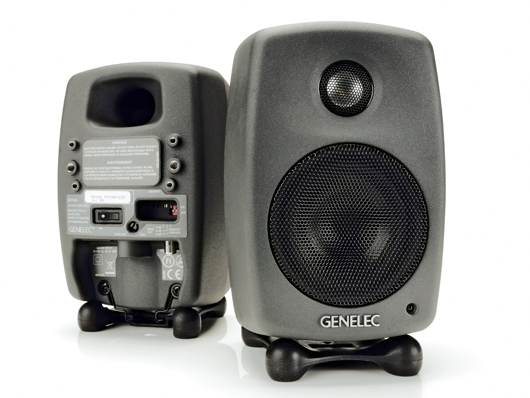
Genelec 6010A
At just under 20cm tall, the 6010As are for those who are short on space or require portability. The grills, aluminium cab and recessed controls make them sturdy; getting at the RCA plug is a fiddly affair, though. The rubber Iso-Pod base isolates the speaker and angles it up or down.
These sound bigger than their dimensions suggest, with a wide, believable stereo image and snappy dynamics. There’s not much real bass and the upper treble rolls off early, but what’s audible is accurate and clear. You shouldn’t feel compelled to compensate for the speakers’ sound when mixing, and by soloing instruments, you’ll be able to make an educated guess at the low-end EQ settings.
You’d be hard-pushed to find a better-sounding speaker of this size, and there’s a matching subwoofer (5040A) to think about, too.
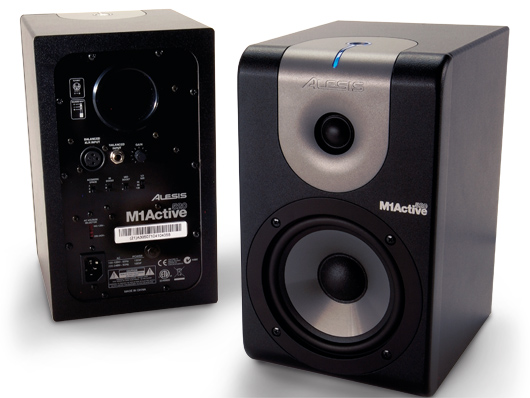
Alesis M1 Active 520
These are the third generation of the M1 Active series and, despite their relatively small size, they can be cranked to considerable levels. Round the back you’ll find both XLR and TRS inputs and cut/boost switches for bass, mid-range and treble. There’s also an acoustic space switch that provides some flexibility when placing these monitors near studio walls.
The Active 520s sound very clean. The treble is shiny without being coloured, and the midrange is solid and dependable without becoming distorted or cluttered. Bass will always be a little compromised on monitors of this size, but the 520s certainly don’t lack weight.
The Alesis M1 Active 520s are good performers that won’t wear you out or give you a false impression of your mix. They do a pretty good job irrespective of the music you’re looking to make.

Yamaha HS80m
The HS series is said to carry on the tradition of Yamaha’s legendary NS line (the ancient NS10 is still a fixture in countless pro studios), and it features the same iconic white cones.
Right off the bat, we were happy with these. The HS80Ms have a sound that’s neutral, detailed, clear and articulate. The agile dynamics enable you to hear such details as vocal plosives in a mix context, and to more easily perceive the ‘shape’ of percussive elements (that is, their amplitude envelope). You get some sense of front-to-back depth and reverb space, too (impressive for the price), and the low end is held down well.
Mixing is straightforward, and the results cohesive and consistent. With a solid, authoritative low end and reverb levels that are also ‘just right’, we definitely recommend the HS80Ms. There’s also a matching subwoofer to consider.
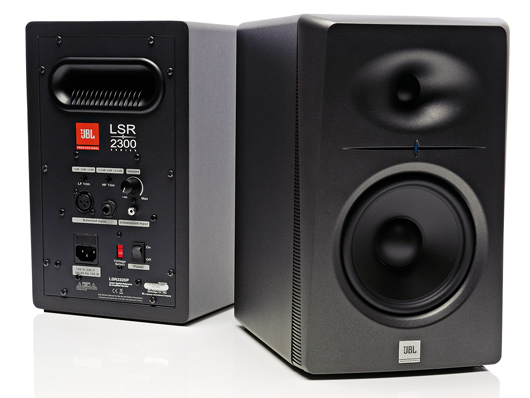
JBL Professional LSR 2325P
The 2325Ps stick to a tried and tested formula, which, at a time when so many other manufacturers are trying to reinvent the wheel, is actually refreshing. They have a bi-amped two-way bass reflex design, a soft dome tweeter, a waveguide built into the front baffle and a rear port. Balanced input is on XLR or 1/4-inch TRS; unbalanced is on RCA.
In use, there’s impressive clarity and a relatively flat response. Stereo imaging is good and the sweet spot’s big enough to work with for nearfield purposes. The LSRs put out a healthy amount of bass, albeit with a hint of the low-end fuzziness that you always seem to get with small drivers and ported enclosures.
These monitors are capable of great results when they like what you’re throwing at them, but it’s a shame that it’s impossible to predict when they’ll struggle with more difficult material.
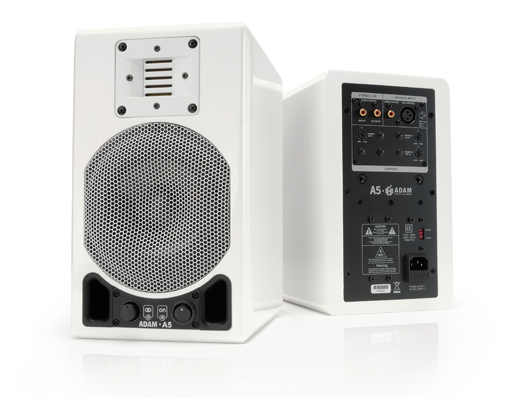
Adam A5
The Adam A5s are a compact take on the popular A7s, featuring the same ART ribbon tweeter.
The dynamic response and treble are highly impressive, with great transient handling. Acoustic material sounds convincing, reverb spaces are audible, and stereo imaging is sharp. The bass and mids are good, too.
When mixing, we attenuated the LF and HF EQ, as the A5s sounded a little bit scooped. It took us a while to hit upon a good mix - virtually every adjustment seemed to make a difference. The ‘shape’ of the drums when tweaking compression was clearer, as was the reverb space. Our final test mix was solid and satisfying, with rocking, nicely squashed compression on the drums.
It might take you a little while to get used to the sound of the tweeter, but these speakers deserve to be heard, as they’re pretty special.

KRK Systems VXT6
The fully curved fascia and sides of the VXT series (there are 4-inch and 8-inch models too) are said to reduce diffraction (sound waves reflected into the soundfield). This, coupled with the front port, makes the VXT6s less fussy about placement and affords them a surprisingly wide sweet spot.
They have a pleasing, subtly exciting tone that’s revealing yet easy on the ear. Stereo imaging is great and bass is tight, musical and quite deep. The treble is a tad softer than in some monitors, though there’s no lack of transient snap. A limiter and auto-power-off are welcome inclusions.
We found the VXT6s great to mix on, though the subtle treble roll-off did bug us. Some perceive such a sound to be more natural, though, so check them out for yourself, as they’re undoubtedly a fine set of monitors. Used in conjunction with some acoustic treatment, they could be great.

M-Audio Studiophile DSM1
These are the smallest monitors in M-Audio’s DSM range, and feature XLR, TRS, S/PDIF and AES/EBU inputs. There are also EQ controls that let you tweak the sound to fit your space.
In use, the bass is solid and focused, while the treble end is also clear without becoming too fizzy and uncomfortable at higher volumes. The mid-range is somewhat less convincing - it almost seems as though busier mixes can’t quite find all the room they need to express themselves, and the mids are the area where this congestion becomes most apparent. On the plus side, the mids don’t sound unpleasantly coloured, which you might argue would be a bigger problem.
Ultimately, the DSM1s are a pretty impressive effort. With this range, M-Audio is certainly signalling its intent to be taken more seriously in the mid-priced monitor market.

APS IO
These monitors, which feature drivers built by SEAS in Norway, are designed for nearfield use - the tweeter and woofer are fed by independent amplifiers which are housed on the monitor enclosure’s back plate, and on the rear there’s a set of switches to ensure acoustic compatibility with your room.
The IOs sound immediately transparent, and we were impressed by the low mid-range in particular. The bass extension is good too, while the top end is clear without being overly abrasive.
The IOs really impressed us, partly because they don’t try too hard to impress. They’re designed to provide an honest listening experience, and while the bass extension can never be fully trusted on a monitor of this size, these speakers are every bit the equal of their main rivals at this price and beyond.
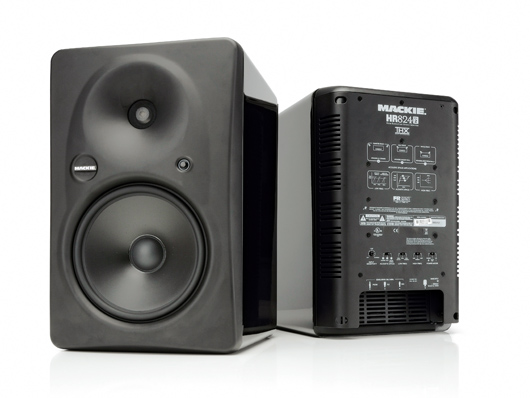
Mackie HR824 MK2
This updated version of Mackie’s industry-standard monitor sports reassuringly large cones and a passive radiator rather than a bass reflex port. It took some work to find a good spot for these - they need decent room acoustics and solid stands.
Delivering trouser-flapping bass, the HR824s’ response is smooth and accurate - we spotted a few sonic details that had previously gone unnoticed. Tiny EQ tweaks and the differences between, say, low- and high-quality modes in certain plug-ins are obvious.
The sound’s not too cold - if anything, these speakers are subtly ‘hi-fi’, making them enjoyable to work with. With heavy material such as DnB, sounds retain separation, and with orchestral material, low-end movement is quite palpable. The HR824s excel at dance and rock styles, too - overall, we think you won’t go far wrong with a set of these.

Genelec 8040A
Finding the best spot for these monitors isn’t tricky - the integrated, tiltable Iso-Pod helps. The sound, meanwhile, is natural, unforced and controlled, with excellent stereo imaging. You get a good sense of the room in which the recording was made, and of that elusive front-to-back depth. Mancini’s score for The Pink Panther, for instance, came across as ‘real’ and less like a recording (much more so than with other monitors), with a convincing 3D soundstage and sweet top-end air.
When mixing, we could hear that our reverb processor was too ‘springy’. There was a graininess to the guitars - a harshness at 1.8kHz - but it turned out to be a problem with the recording that we hadn’t spotted, so it was actually a plus.
These are excellent monitors for any genre, with their superior handling of acoustic material showing just how classy they are.

Focal Professional Twin6 Be
These are near/midfield analogue monitors that are designed for horizontal or vertical placement and feature a three-way actively amplified design.
The beryllium tweeters provide super-tight, clear and accurate high-end response, producing amazing levels of detail and clarity in the hi-hats, vocals and beyond. The mid-range is extremely revealing, putting many other speakers to shame and enabling you to zoom deep into your mixes. Low-frequency response is tight, accurate and punchy, giving you a speaker that enables you to hear problem frequencies immediately.
The Twin6 Bes have a fantastic stereo image and a wide sweet spot, can handle all styles/genres and aren’t fatiguing. They’re not cheap, but you’re paying for one of the most accurate and transparent monitors on the market. Our only gripe is that the control switches would be better on the front.

Acoustic Energy AE22
For the AE22, Acoustic Energy looked at the properties that made Yamaha’s NS10s so popular in the studio and designed a set of monitors with these same attributes in mind. What we have here are closed-cabinet non-reflex speakers, with a low distortion and crossover frequency of 2kHz.
Although the bottom end isn’t extended, it’s so tight that we found it really informative. Top end is clean, not overly crispy and just as useful. Where the AE22s really shine, however, is in the mid-range. It’s solid, crystal clear and doesn’t tire your ears, making it easy to balance vocals in a track.
These are remarkable speakers. They’re not designed to impress, but rather to assess the sound and give the engineer a clear picture of what needs to be done. As a result, we can’t recommend them highly enough.
Read the full Acoustic Energy AE22 review
For a fast guide to monitoring, check out Computer Music Special 39, Fix Your Mix, which is on sale now.